



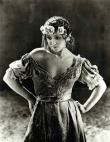
1 April
 Do Detectives Think (Dir. Fred Guiol, US, 1927) + Habeas Corpus (Dir. Leo McCarey/James Parrott, Us, 1928) + Double Whoopee (Dir. Lewis R Foster, US, 1929) + Leave ‘Em Laughing (Dir. Clyde Bruckman, US, 1928) (Screening format – not known, 19/20/20/21 mins). In Do Detectives Think, when an escaped convict vows
Do Detectives Think (Dir. Fred Guiol, US, 1927) + Habeas Corpus (Dir. Leo McCarey/James Parrott, Us, 1928) + Double Whoopee (Dir. Lewis R Foster, US, 1929) + Leave ‘Em Laughing (Dir. Clyde Bruckman, US, 1928) (Screening format – not known, 19/20/20/21 mins). In Do Detectives Think, when an escaped convict vows  revenge on the judge who sentenced him, the judge engages a detective agency which sends its two best men, Laurel and Hardy, to protect him! In Habeus Corpus, the boys are hired by the mad Professor Padilla to steal a body from a local graveyard on which he can carry out his experiments. But the ‘body’ isn’t as dead as they think! Double Whoopee sees the boys as humble employees at a swanky hotel leaving chaos in their wake. Look out for a brief appearance by Jean Harlow. In Leave ‘Em Laughing , when Stan gets toothache Ollie tries to help, but the more he helps, the more things go wrong! Look out for Edgar Kennedy making his first of many appearances in a L&H film. Find out more at laurel-and-hardy.com. With live organ accompaniment by Donald Mackenzie. Regent Street Cinema, London Link
revenge on the judge who sentenced him, the judge engages a detective agency which sends its two best men, Laurel and Hardy, to protect him! In Habeus Corpus, the boys are hired by the mad Professor Padilla to steal a body from a local graveyard on which he can carry out his experiments. But the ‘body’ isn’t as dead as they think! Double Whoopee sees the boys as humble employees at a swanky hotel leaving chaos in their wake. Look out for a brief appearance by Jean Harlow. In Leave ‘Em Laughing , when Stan gets toothache Ollie tries to help, but the more he helps, the more things go wrong! Look out for Edgar Kennedy making his first of many appearances in a L&H film. Find out more at laurel-and-hardy.com. With live organ accompaniment by Donald Mackenzie. Regent Street Cinema, London Link
2 April
 The Lost World (Dir. Harry Hoyt, US, 1925) (Screening format – not known, 106mins) Arthur Conan Doyle’s dinosaur adventure is
The Lost World (Dir. Harry Hoyt, US, 1925) (Screening format – not known, 106mins) Arthur Conan Doyle’s dinosaur adventure is 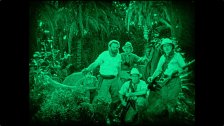 brought to the big screen for the first time in an adventure across continents to the land that time forgot, featuring swooping beasts, the terrifying ‘apeman’ and the odd volcano too! This film used pioneering techniques in stop motion by Willis O’Brien (a forerunner of his work on the original King Kong film) and was one of the first to use a tinting technique that brought colour to film. It also features an introduction from the author himself. Find out more at moviessilently.com. With live piano accompaniment from Jonny Best. Hyde Park Picture House, Leeds Link
brought to the big screen for the first time in an adventure across continents to the land that time forgot, featuring swooping beasts, the terrifying ‘apeman’ and the odd volcano too! This film used pioneering techniques in stop motion by Willis O’Brien (a forerunner of his work on the original King Kong film) and was one of the first to use a tinting technique that brought colour to film. It also features an introduction from the author himself. Find out more at moviessilently.com. With live piano accompaniment from Jonny Best. Hyde Park Picture House, Leeds Link
6 April
 The Lodger: A Story of the London Fog (Dir. Alfred Hitchcock, UK, 1927) (Screening format – not known, 91 mins ) In The Lodger, a serial killer known as “The Avenger” is on the loose in London, murdering blonde women. A mysterious man (Ivor Novello) arrives at the house of Mr. and Mrs. Bunting looking for a room to rent. The Bunting’s daughter (June Tripp) is a blonde model and is seeing one of the detectives (Malcolm Keen) assigned to the case. The detective becomes
The Lodger: A Story of the London Fog (Dir. Alfred Hitchcock, UK, 1927) (Screening format – not known, 91 mins ) In The Lodger, a serial killer known as “The Avenger” is on the loose in London, murdering blonde women. A mysterious man (Ivor Novello) arrives at the house of Mr. and Mrs. Bunting looking for a room to rent. The Bunting’s daughter (June Tripp) is a blonde model and is seeing one of the detectives (Malcolm Keen) assigned to the case. The detective becomes  jealous of the lodger and begins to suspect he may be the #avenger. Based on a best-selling novel by Marie Belloc Lowndes, first published in 1913, loosely based on the Jack the Ripper murders, The Lodger was Hitchcock’s first thriller, and his first critical and commercial success. Made shortly after his return from Germany, the film betrays the influence of the German expressionist tradition established in such films as The Cabinet of Dr. Caligari (1919) and Nosferatu (1922). Find out more at silentfilm.org Presented by the Beaconsfield Film Society. With live musical accompaniment and an introductory talk by Marisa and Daniel Cornford. National Film and Television School , Beaconsfield. Link
jealous of the lodger and begins to suspect he may be the #avenger. Based on a best-selling novel by Marie Belloc Lowndes, first published in 1913, loosely based on the Jack the Ripper murders, The Lodger was Hitchcock’s first thriller, and his first critical and commercial success. Made shortly after his return from Germany, the film betrays the influence of the German expressionist tradition established in such films as The Cabinet of Dr. Caligari (1919) and Nosferatu (1922). Find out more at silentfilm.org Presented by the Beaconsfield Film Society. With live musical accompaniment and an introductory talk by Marisa and Daniel Cornford. National Film and Television School , Beaconsfield. Link
10 April
 Blind Husbands (Dir. Erich von Stroheim, US, 1919) (Screening format – not known, 99mins) In Erich von Stroheim’s directorial debut an Austrian officer sets out to seduce a neglected young wife. In suggesting that a woman had the right to seek love outside of an unsatisfying marriage, the film presents quite an advanced moral viewpoint for its
Blind Husbands (Dir. Erich von Stroheim, US, 1919) (Screening format – not known, 99mins) In Erich von Stroheim’s directorial debut an Austrian officer sets out to seduce a neglected young wife. In suggesting that a woman had the right to seek love outside of an unsatisfying marriage, the film presents quite an advanced moral viewpoint for its  time and the film is now considered a masterpiece of the silent era. Born in 1885 into a Jewish family of hat-makers in Vienna, Stroheim emigrated to the USA in 1909 where became one of the greatest Austrian film directors of the silent era. His reputation for extravagance, insistence on complete artistic freedom regardless of economic considerations, and his uncompromising and sophisticated treatment of controversial subject matters ended his career as a Hollywood director in the late 1920s. Find out more at obscurehollywood.net. With recorded soundtrack. Austrian Cultural Forum, London SW7 Link
time and the film is now considered a masterpiece of the silent era. Born in 1885 into a Jewish family of hat-makers in Vienna, Stroheim emigrated to the USA in 1909 where became one of the greatest Austrian film directors of the silent era. His reputation for extravagance, insistence on complete artistic freedom regardless of economic considerations, and his uncompromising and sophisticated treatment of controversial subject matters ended his career as a Hollywood director in the late 1920s. Find out more at obscurehollywood.net. With recorded soundtrack. Austrian Cultural Forum, London SW7 Link
11 April
 The Canadian (Dir. William Beaudine, US, 1926) (Screening format – not known, 80 mins) Adapted by Arthur Stringer from W. Somerset Maugham’s 1913 Broadway play The Land of Promise, The Canadian was produced by Famous Players-Lasky and directed by William Beaudine. Its star, Thomas Meighan, had previously appeared in a 1917 adaptation (retaining the play’s original title) with Billie Burke as his leading lady. In this remake she is replaced by Mona Palmer, as a refined Englishwoman who finds it expedient to enter into marriage with an unsophisticated wheat farmer in Alberta, Canada. This unsteady match faces greater tribulations amid hostile weather and burgeoning financial problems. Find out more at silentfilm.org A Kennington Bioscope presentation. With live musical accompaniment. The Cinema Museum, Lambeth Link
The Canadian (Dir. William Beaudine, US, 1926) (Screening format – not known, 80 mins) Adapted by Arthur Stringer from W. Somerset Maugham’s 1913 Broadway play The Land of Promise, The Canadian was produced by Famous Players-Lasky and directed by William Beaudine. Its star, Thomas Meighan, had previously appeared in a 1917 adaptation (retaining the play’s original title) with Billie Burke as his leading lady. In this remake she is replaced by Mona Palmer, as a refined Englishwoman who finds it expedient to enter into marriage with an unsophisticated wheat farmer in Alberta, Canada. This unsteady match faces greater tribulations amid hostile weather and burgeoning financial problems. Find out more at silentfilm.org A Kennington Bioscope presentation. With live musical accompaniment. The Cinema Museum, Lambeth Link
12 April
 Arsenal (Dir. Aleksandr Dovzhenko, USSR, 1928) (Screening format – not known, 87mins) Soldiers return to Ukraine to find their homeland teeming with strife and dissension, gripped in a conflict between nationalist forces and communists. One faction of soldiers, led by Timosh (Semyon Svashenko) supports the communists and takes command of a munitions factory at Kiev,
Arsenal (Dir. Aleksandr Dovzhenko, USSR, 1928) (Screening format – not known, 87mins) Soldiers return to Ukraine to find their homeland teeming with strife and dissension, gripped in a conflict between nationalist forces and communists. One faction of soldiers, led by Timosh (Semyon Svashenko) supports the communists and takes command of a munitions factory at Kiev,  converting the weapons arsenal into a fortress. Still reeling from the trauma of war, Timosh and his comrades engage in a violent crusade that soon spreads across Ukraine. The second half pivots on the collision of Ukrainian nationalism and Soviet power with the Reds and the Whites, the Kiev strike, massacres and executions,
converting the weapons arsenal into a fortress. Still reeling from the trauma of war, Timosh and his comrades engage in a violent crusade that soon spreads across Ukraine. The second half pivots on the collision of Ukrainian nationalism and Soviet power with the Reds and the Whites, the Kiev strike, massacres and executions,  religious processions with serpentine banners and mighty, bushy moustaches in extreme close-up! Dovzhenko’s progressive approach to editing – he was one of the pioneers of Soviet Montage – camerawork and narrative construction mark him out as an enduringly distinctive voice whose films retain their importance to this day. Find out more at imdb.com . This avant garde film was compared to Pablo Picasso’s Guernica because of director’s frank depiction of war. Arsenal made Dovzhenko famous not only in the Soviet Union, but also in Western Europe and North America. Ultimately, the National Society of American Film Critics named
religious processions with serpentine banners and mighty, bushy moustaches in extreme close-up! Dovzhenko’s progressive approach to editing – he was one of the pioneers of Soviet Montage – camerawork and narrative construction mark him out as an enduringly distinctive voice whose films retain their importance to this day. Find out more at imdb.com . This avant garde film was compared to Pablo Picasso’s Guernica because of director’s frank depiction of war. Arsenal made Dovzhenko famous not only in the Soviet Union, but also in Western Europe and North America. Ultimately, the National Society of American Film Critics named  Arsenal one of the five best films of 1929, along with Karl Theodor Dreyer’s The Passion of Joan of Arc. Thematically, the film is close to The Enchanted Place: Dovzhenko’s focus is once again on revolution and civil war in Ukraine, particularly the events that took place at the end of World War I which resulted in an unsuccessful Bolshevik uprising in January 1918 in Kyiv. In Soviet mythology, the uprising at the Arsenal factory is one of the key episodes in the tale of Bolshevik martyrdom in Ukraine. Dovzhenko, enthusiastic about the ideas of national liberation and social revolution, took the events of the uprising to the narrative’s margins, ultimately creating a political film for Ukrainian intelligentsia on both sides of the barricades of the civil war. A vague portrayal of the opposing forces of the uprising and parallel editing of different events leave the viewer with a sense of the chaos of war, rather than with a clear political message or a forced interpretation. At the same time idiosyncratic acting, expressive lighting, camerawork and editing enable the director to bring to life the stories of individual characters and cast them into a broader historical canvas and a clear pacifist message. Find out more at filmreference.com . Presented as part of the Site Festival. With live musical accompaniment by Bronnt Industries Kapital. SVA Goods Yard, Stroud,Gloucestershire Link
Arsenal one of the five best films of 1929, along with Karl Theodor Dreyer’s The Passion of Joan of Arc. Thematically, the film is close to The Enchanted Place: Dovzhenko’s focus is once again on revolution and civil war in Ukraine, particularly the events that took place at the end of World War I which resulted in an unsuccessful Bolshevik uprising in January 1918 in Kyiv. In Soviet mythology, the uprising at the Arsenal factory is one of the key episodes in the tale of Bolshevik martyrdom in Ukraine. Dovzhenko, enthusiastic about the ideas of national liberation and social revolution, took the events of the uprising to the narrative’s margins, ultimately creating a political film for Ukrainian intelligentsia on both sides of the barricades of the civil war. A vague portrayal of the opposing forces of the uprising and parallel editing of different events leave the viewer with a sense of the chaos of war, rather than with a clear political message or a forced interpretation. At the same time idiosyncratic acting, expressive lighting, camerawork and editing enable the director to bring to life the stories of individual characters and cast them into a broader historical canvas and a clear pacifist message. Find out more at filmreference.com . Presented as part of the Site Festival. With live musical accompaniment by Bronnt Industries Kapital. SVA Goods Yard, Stroud,Gloucestershire Link
13 April
 Nanook of the North (Dir. Robert J Flaherty, US, 1922) (Screening format – not known, 79 mins) Robert Flaherty’s classic film tells the story of Inuit hunter Nanook and his
Nanook of the North (Dir. Robert J Flaherty, US, 1922) (Screening format – not known, 79 mins) Robert Flaherty’s classic film tells the story of Inuit hunter Nanook and his  family as they struggle to survive in the harsh conditions of Canada’s Hudson Bay region. Enormously popular when released in 1922, Nanook of the North is a cinematic milestone that continues to enchant audiences. Filmed from 1920-1921 in Port Harrison, Northern Quebec by Robert Joseph Flaherty, this was the first successful documentary ever made, and was a true benchmark for
family as they struggle to survive in the harsh conditions of Canada’s Hudson Bay region. Enormously popular when released in 1922, Nanook of the North is a cinematic milestone that continues to enchant audiences. Filmed from 1920-1921 in Port Harrison, Northern Quebec by Robert Joseph Flaherty, this was the first successful documentary ever made, and was a true benchmark for  ethnographic film. Flaherty brought and entirely unknown culture to the western world. It describes the trading, hunting, fishing and migrations of a group barely touched by industrial technology. Nanook of the North was widely shown and praised as the first full-length, anthropological documentary in cinematographic history. Find out more at www.rogerebert.com. Cube Cinema, Bristol (No Link Yet)
ethnographic film. Flaherty brought and entirely unknown culture to the western world. It describes the trading, hunting, fishing and migrations of a group barely touched by industrial technology. Nanook of the North was widely shown and praised as the first full-length, anthropological documentary in cinematographic history. Find out more at www.rogerebert.com. Cube Cinema, Bristol (No Link Yet)
15 April
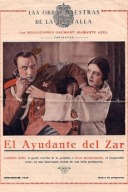 The Adjutant of the Czar (Dir. Vladimir Strizhevsky, Ger, 1929) (Screening format – DCP, 98mins) Half screwball, half melodrama, this vehicle for one of the silent
The Adjutant of the Czar (Dir. Vladimir Strizhevsky, Ger, 1929) (Screening format – DCP, 98mins) Half screwball, half melodrama, this vehicle for one of the silent 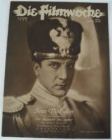 era’s greatest romantic leads, Ivan Mozzhukhin, makes full use of those soulful, penetrating eyes. This little-known film tells of a lighter-than-air romance between a Czarist officer and a passport-less girl who are obliged to share a sleeper compartment on an overnight train. Their burgeoning
era’s greatest romantic leads, Ivan Mozzhukhin, makes full use of those soulful, penetrating eyes. This little-known film tells of a lighter-than-air romance between a Czarist officer and a passport-less girl who are obliged to share a sleeper compartment on an overnight train. Their burgeoning  relationship is tested when revolutionary zeal meets implacable loyalty in the heightened atmosphere of pre-revolutionary Russia. Find out more at wikipedia.org . With live piano accompaniment. Introduced by the BFI’s Bryony Dixon. BFI Southbank, London (No link yet)
relationship is tested when revolutionary zeal meets implacable loyalty in the heightened atmosphere of pre-revolutionary Russia. Find out more at wikipedia.org . With live piano accompaniment. Introduced by the BFI’s Bryony Dixon. BFI Southbank, London (No link yet)
17 April
 Haxan: Witchcraft Through the Ages (Dir. Benjamin Christensen, Swe., 1922) ( Screening format – not known, 105mins) A fictionalized documentary with dramatic reconstructions showing the evolution of witchcraft, from its pagan roots to its confusion with hysteria in modern
Haxan: Witchcraft Through the Ages (Dir. Benjamin Christensen, Swe., 1922) ( Screening format – not known, 105mins) A fictionalized documentary with dramatic reconstructions showing the evolution of witchcraft, from its pagan roots to its confusion with hysteria in modern  (1922) Europe. Based partly on Christensen’s study of the Malleus Maleficarum, a 15th-century German guide for inquisitors, Häxan is a study of how superstition and the misunderstanding of diseases and mental illness could lead to the hysteria of the witch hunts. Although it won acclaim in Denmark and Sweden when first released, Haxan was heavily censored or banned outright in many countries. But it is now considered to be
(1922) Europe. Based partly on Christensen’s study of the Malleus Maleficarum, a 15th-century German guide for inquisitors, Häxan is a study of how superstition and the misunderstanding of diseases and mental illness could lead to the hysteria of the witch hunts. Although it won acclaim in Denmark and Sweden when first released, Haxan was heavily censored or banned outright in many countries. But it is now considered to be  Christensen’s finest work, a witches’ brew of the scary, the grotesque, and the darkly humorous. Find out more at thedevilsmanor.blogspot.co.uk . Presented as part of Birmingham’s Flatpack Festival. Reece Shearsmith (The League of Gentlemen, High Rise, A Field in England), will be narrating a live translation of the Swedish inter-titles and renowned musician Stephen Horne will be providing live musical accompaniment. Town Hall, Birmingham. Link
Christensen’s finest work, a witches’ brew of the scary, the grotesque, and the darkly humorous. Find out more at thedevilsmanor.blogspot.co.uk . Presented as part of Birmingham’s Flatpack Festival. Reece Shearsmith (The League of Gentlemen, High Rise, A Field in England), will be narrating a live translation of the Swedish inter-titles and renowned musician Stephen Horne will be providing live musical accompaniment. Town Hall, Birmingham. Link
19 April
 Arsenal (Dir. Aleksandr Dovzhenko, USSR, 1928) (Screening format – not known, 87mins) This avant garde film was compared to Pablo Picasso’s Guernica because of the director’s frank depiction of war. Arsenal made Dovzhenko famous not only in the Soviet Union, but also in Western Europe and North America. Ultimately, the National Society of American Film Critics named Arsenal one of the five best films of 1929, along with Karl Theodor Dreyer’s The Passion of Joan of Arc. Thematically, the film is close to The Enchanted Place: Dovzhenko’s focus is once again on revolution and civil war in Ukraine, particularly the events that took place at the end of World War I which resulted in an unsuccessful Bolshevik uprising in January 1918 in Kyiv. In Soviet mythology, the uprising at the Arsenal factory is one of the key episodes in the tale of Bolshevik martyrdom in Ukraine. Dovzhenko, enthusiastic about the ideas of national liberation and social revolution, took the events of the uprising to the narrative’s margins, ultimately creating a political film for Ukrainian intelligentsia on both sides of the barricades of the civil war. A vague portrayal of the opposing forces of the uprising and parallel editing of different events leave the viewer with a sense of the chaos of war, rather than with a clear political message or a forced interpretation. At the same time idiosyncratic acting, expressive lighting, camerawork and editing enable the director to bring to life the stories of individual characters and cast them into a broader historical canvas and a clear pacifist message. Find out more at filmreference.com . With live musical accompaniment from Bronnt Industries Kapital MAC, Belfast Link
Arsenal (Dir. Aleksandr Dovzhenko, USSR, 1928) (Screening format – not known, 87mins) This avant garde film was compared to Pablo Picasso’s Guernica because of the director’s frank depiction of war. Arsenal made Dovzhenko famous not only in the Soviet Union, but also in Western Europe and North America. Ultimately, the National Society of American Film Critics named Arsenal one of the five best films of 1929, along with Karl Theodor Dreyer’s The Passion of Joan of Arc. Thematically, the film is close to The Enchanted Place: Dovzhenko’s focus is once again on revolution and civil war in Ukraine, particularly the events that took place at the end of World War I which resulted in an unsuccessful Bolshevik uprising in January 1918 in Kyiv. In Soviet mythology, the uprising at the Arsenal factory is one of the key episodes in the tale of Bolshevik martyrdom in Ukraine. Dovzhenko, enthusiastic about the ideas of national liberation and social revolution, took the events of the uprising to the narrative’s margins, ultimately creating a political film for Ukrainian intelligentsia on both sides of the barricades of the civil war. A vague portrayal of the opposing forces of the uprising and parallel editing of different events leave the viewer with a sense of the chaos of war, rather than with a clear political message or a forced interpretation. At the same time idiosyncratic acting, expressive lighting, camerawork and editing enable the director to bring to life the stories of individual characters and cast them into a broader historical canvas and a clear pacifist message. Find out more at filmreference.com . With live musical accompaniment from Bronnt Industries Kapital MAC, Belfast Link
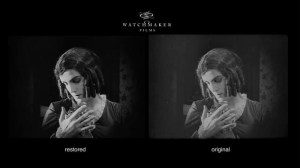 A Restoration of Nosferatu (1922) This show-and-tell lecture will illustrate many of the issues encountered and (with varying degrees of success) resolved in a digital restoration of Murnau’s Nosferatu. This talk will begin with a description of the original production and the technology used to make the film. The film’s own troubled history complicated the film’s physical reconstruction, and that impacted the digital restoration. This talk will primarily explore the complex and subjective issues currently floating around in many analog-versus-digital discussions of film and how those opinions can influence the determination of what the restored version should look like if the goal is to replicate the original projected image at the time of first release. Can digital restorations generate valid preservation copies of photo-chemical materials? Presented by The Miskatonic Institute Of Horror Studies. Introduced by Mark Rance. The Horse Hospital, Colonnade, Bloomsbury, London. Link
A Restoration of Nosferatu (1922) This show-and-tell lecture will illustrate many of the issues encountered and (with varying degrees of success) resolved in a digital restoration of Murnau’s Nosferatu. This talk will begin with a description of the original production and the technology used to make the film. The film’s own troubled history complicated the film’s physical reconstruction, and that impacted the digital restoration. This talk will primarily explore the complex and subjective issues currently floating around in many analog-versus-digital discussions of film and how those opinions can influence the determination of what the restored version should look like if the goal is to replicate the original projected image at the time of first release. Can digital restorations generate valid preservation copies of photo-chemical materials? Presented by The Miskatonic Institute Of Horror Studies. Introduced by Mark Rance. The Horse Hospital, Colonnade, Bloomsbury, London. Link
20 April
 Behind The Door (Dir. Irvin Willat, 1919) (Screening format – not known, 70mins) With America entering World War I, German-American Oscar Krug (Hobart Bosworth) is thought to be an enemy sympathizer. He fights his foes to prove that they’re wrong, then immediately enlists and is assigned to the merchant marines. The night before boarding, he marries his sweetheart, Alice Morse (Jane Novak), and she sails with him. A German submarine torpedoes the craft and sinks it. Krug and his bride board a lifeboat. The Germans take Alice and leave Krug, who swears revenge to the commander (Wallace Beery)…. Restored from surviving incomplete copies held at the US Library of Congress and at the Gosfilmofond, the Russian national archive so that what Kevin Brownlow called “the most outspoken of all the [WWI] vengeance films,” can now be seen in its most complete form since its release in 1919. And it is possibly the ‘darkest’ silent film we have ever seen. Find out more at silentfilm.org . Accompanied by a new recorded score by highly celebrated silent film pianist, Stephen Horne. The Landmark, Ilfracombe, Devon Link
Behind The Door (Dir. Irvin Willat, 1919) (Screening format – not known, 70mins) With America entering World War I, German-American Oscar Krug (Hobart Bosworth) is thought to be an enemy sympathizer. He fights his foes to prove that they’re wrong, then immediately enlists and is assigned to the merchant marines. The night before boarding, he marries his sweetheart, Alice Morse (Jane Novak), and she sails with him. A German submarine torpedoes the craft and sinks it. Krug and his bride board a lifeboat. The Germans take Alice and leave Krug, who swears revenge to the commander (Wallace Beery)…. Restored from surviving incomplete copies held at the US Library of Congress and at the Gosfilmofond, the Russian national archive so that what Kevin Brownlow called “the most outspoken of all the [WWI] vengeance films,” can now be seen in its most complete form since its release in 1919. And it is possibly the ‘darkest’ silent film we have ever seen. Find out more at silentfilm.org . Accompanied by a new recorded score by highly celebrated silent film pianist, Stephen Horne. The Landmark, Ilfracombe, Devon Link
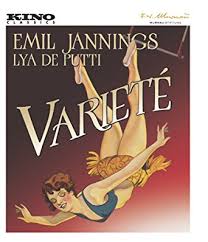 Variety (Dir. E A Dupont, Ger, 1925) (Screening format – not known, 94mins) Actor Emil Jannings was one of the most esteemed actors of this time, working with directors such as F.W. Murnau and Josef von Sternberg, before moving to America to become the first winner of the Oscar for Best Actor, and ending his career in disgrace after appearing in Nazi propaganda films. In this seamy melodrama, he plays Boss Huller, a former trapeze artist who abandons his family for a younger colleague
Variety (Dir. E A Dupont, Ger, 1925) (Screening format – not known, 94mins) Actor Emil Jannings was one of the most esteemed actors of this time, working with directors such as F.W. Murnau and Josef von Sternberg, before moving to America to become the first winner of the Oscar for Best Actor, and ending his career in disgrace after appearing in Nazi propaganda films. In this seamy melodrama, he plays Boss Huller, a former trapeze artist who abandons his family for a younger colleague  (Lya De Putti). When the couple becomes a professional trio, a love triangle is formed, and tragedy ensues. The film features some of the most inventive camerawork of the period, its ‘unchained’ approach making for breathtaking performance scenes.Find out more at moviessilently.com . Presented as part of the Flatpack Festival. With a live performance of trapeze, ground based acrobatics, acrobalance and physical theatre, whilst multi-instrumentalist Stephen Horne and percussionist Martin Pyne will provide the live soundtrack. RoguePlay Theatre, Minerva Works, Birmingham Link
(Lya De Putti). When the couple becomes a professional trio, a love triangle is formed, and tragedy ensues. The film features some of the most inventive camerawork of the period, its ‘unchained’ approach making for breathtaking performance scenes.Find out more at moviessilently.com . Presented as part of the Flatpack Festival. With a live performance of trapeze, ground based acrobatics, acrobalance and physical theatre, whilst multi-instrumentalist Stephen Horne and percussionist Martin Pyne will provide the live soundtrack. RoguePlay Theatre, Minerva Works, Birmingham Link
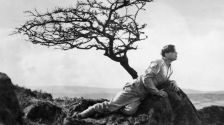 Cottage on Dartmoor (Dir. Anthony Asquith, 1929) (Screening format – not known, 84mins) Joe (Uno Henning) works as a barber in a shop in a Devon town, alongside a manicurist called Sally (Norah Baring). He becomes infatuated with her and asks her out but it is clear that Sally does not reciprocate Joe’s feelings. Joe’s infatuation with her develops into obsession. Meanwhile a young farmer Harry (Hans Schlettow), begins to woo Sally and the couple begin seeing each other which leaves Joe in despair. After a fight with Harry, Joe is jailed but swears revenge on Harry and Sally. A Cottage on Dartmoor is a tale of love and revenge set in the bleak landscape of Dartmoor and a thoughtful distillation of the best of European silent film techniques from a director steeped in the work of the Soviet avant-garde and German expressionism. One of the last films of the silent era and a virtuoso piece of film-making, A Cottage on Dartmoor was a final passionate cry in defence of an art form soon to be obsolete. Find out more at silentfilm.org. With live musical accompaniment from Wurlitza. The Tolmen Centre, Constantine, Cornwall. Link
Cottage on Dartmoor (Dir. Anthony Asquith, 1929) (Screening format – not known, 84mins) Joe (Uno Henning) works as a barber in a shop in a Devon town, alongside a manicurist called Sally (Norah Baring). He becomes infatuated with her and asks her out but it is clear that Sally does not reciprocate Joe’s feelings. Joe’s infatuation with her develops into obsession. Meanwhile a young farmer Harry (Hans Schlettow), begins to woo Sally and the couple begin seeing each other which leaves Joe in despair. After a fight with Harry, Joe is jailed but swears revenge on Harry and Sally. A Cottage on Dartmoor is a tale of love and revenge set in the bleak landscape of Dartmoor and a thoughtful distillation of the best of European silent film techniques from a director steeped in the work of the Soviet avant-garde and German expressionism. One of the last films of the silent era and a virtuoso piece of film-making, A Cottage on Dartmoor was a final passionate cry in defence of an art form soon to be obsolete. Find out more at silentfilm.org. With live musical accompaniment from Wurlitza. The Tolmen Centre, Constantine, Cornwall. Link
21 April
 The Lost World (Dir. Harry Hoyt, US, 1925) (Screening format – not known, 106mins) Arthur Conan Doyle’s dinosaur adventure is brought to the big screen for the first time in an adventure across continents to the land that time forgot, featuring swooping beasts, the terrifying ‘apeman’ and the odd volcano too! This film used pioneering techniques in stop motion by Willis O’Brien (a forerunner of his work on the original King Kong film) and was one of the first to use a tinting technique that brought colour to film. It also features an introduction from the author himself. Find out more at moviessilently.com With recorded score. The Landmark, Ilfracombe, Devon Link
The Lost World (Dir. Harry Hoyt, US, 1925) (Screening format – not known, 106mins) Arthur Conan Doyle’s dinosaur adventure is brought to the big screen for the first time in an adventure across continents to the land that time forgot, featuring swooping beasts, the terrifying ‘apeman’ and the odd volcano too! This film used pioneering techniques in stop motion by Willis O’Brien (a forerunner of his work on the original King Kong film) and was one of the first to use a tinting technique that brought colour to film. It also features an introduction from the author himself. Find out more at moviessilently.com With recorded score. The Landmark, Ilfracombe, Devon Link
 The Lodger: A Story of the London Fog (Dir. Alfred Hitchcock, UK, 1927) (Screening format – not known, 91
The Lodger: A Story of the London Fog (Dir. Alfred Hitchcock, UK, 1927) (Screening format – not known, 91  mins ) In The Lodger, a serial killer known as “The Avenger” is on the loose in London, murdering blonde women. A mysterious man (Ivor Novello) arrives at the house of Mr. and Mrs. Bunting looking for a room to rent. The Bunting’s daughter (June Tripp) is a blonde model and is seeing one of the detectives (Malcolm Keen) assigned to the case. The detective becomes jealous of the lodger and begins to suspect he may be the avenger. Based on a best-selling novel by Marie Belloc Lowndes, first published in 1913, loosely based on the Jack the Ripper murders, The Lodger was Hitchcock’s first thriller, and his first critical and commercial success. Made shortly after his return from Germany, the film betrays the influence of the German expressionist tradition established in such films as The Cabinet of Dr. Caligari (1919) and Nosferatu (1922). Find out more at silentfilm.org. Presented as part of the Flatpack Festival. With live musical accompaniment by the Meg Morley Trio. The Royal Birmingham Conservatoire, Birmingham Link
mins ) In The Lodger, a serial killer known as “The Avenger” is on the loose in London, murdering blonde women. A mysterious man (Ivor Novello) arrives at the house of Mr. and Mrs. Bunting looking for a room to rent. The Bunting’s daughter (June Tripp) is a blonde model and is seeing one of the detectives (Malcolm Keen) assigned to the case. The detective becomes jealous of the lodger and begins to suspect he may be the avenger. Based on a best-selling novel by Marie Belloc Lowndes, first published in 1913, loosely based on the Jack the Ripper murders, The Lodger was Hitchcock’s first thriller, and his first critical and commercial success. Made shortly after his return from Germany, the film betrays the influence of the German expressionist tradition established in such films as The Cabinet of Dr. Caligari (1919) and Nosferatu (1922). Find out more at silentfilm.org. Presented as part of the Flatpack Festival. With live musical accompaniment by the Meg Morley Trio. The Royal Birmingham Conservatoire, Birmingham Link
 The Cameraman (Dir. Edward Sedgwick/Buster Keaton, US, 1928) (Screening format – not known, 67mins) Buster (Buster Keaton) meets Sally (Marceline Day), who works as a secretary for the newsreel department at MGM, and falls hard. Trying to win her attention, Buster abandons photography in order to become a news cameraman. In spite of his early failures with a motion camera, Sally takes to him as well. However, veteran cameraman Stagg (Harold Goodwin) also fancies Sally, meaning Buster will need to learn how to film quickly before he loses his job. Find out more at slantmagazine.com. With live organ accompaniment by Donald MacKenzie. Wilmslow Parish Church, Wilmslow Link
The Cameraman (Dir. Edward Sedgwick/Buster Keaton, US, 1928) (Screening format – not known, 67mins) Buster (Buster Keaton) meets Sally (Marceline Day), who works as a secretary for the newsreel department at MGM, and falls hard. Trying to win her attention, Buster abandons photography in order to become a news cameraman. In spite of his early failures with a motion camera, Sally takes to him as well. However, veteran cameraman Stagg (Harold Goodwin) also fancies Sally, meaning Buster will need to learn how to film quickly before he loses his job. Find out more at slantmagazine.com. With live organ accompaniment by Donald MacKenzie. Wilmslow Parish Church, Wilmslow Link
22 April
 London Symphony (Dir. Alex Barrett, UK, 2017) (Screening format – not known) London Symphony is a brand new silent film – a city symphony – which offers a poetic journey through London, a cosmopolitan city facing a challenge to its identity in the current political climate. It is an artistic portrait of the city as it stands today, and a celebration of its culture and diversity. Find out more at londonsymphfilm.com . With recorded score. Picture House Central, London. Link
London Symphony (Dir. Alex Barrett, UK, 2017) (Screening format – not known) London Symphony is a brand new silent film – a city symphony – which offers a poetic journey through London, a cosmopolitan city facing a challenge to its identity in the current political climate. It is an artistic portrait of the city as it stands today, and a celebration of its culture and diversity. Find out more at londonsymphfilm.com . With recorded score. Picture House Central, London. Link
 Adventures of Prince Achmed (Dir. Lotte Reiniger , Ger, 1926) (Screening format – not known, 65mins) The first feature-length animation in film history, masterminded by Lotte Reiniger and hand-tinted frame by frame. Based on ‘The Arabian Nights’, the film tells the epic tale of Prince Achmed, who is tricked into mounting a magical flying horse by a wicked sorcerer.
Adventures of Prince Achmed (Dir. Lotte Reiniger , Ger, 1926) (Screening format – not known, 65mins) The first feature-length animation in film history, masterminded by Lotte Reiniger and hand-tinted frame by frame. Based on ‘The Arabian Nights’, the film tells the epic tale of Prince Achmed, who is tricked into mounting a magical flying horse by a wicked sorcerer.  The horse carries Achmed off on a series of adventures, over the course of which he joins forces with young Aladdin, battles ogres and monsters and romances the beautiful Princess Peri Banu.Find out more at wikipedia.org . Presented as part of the Flatpack Festival. The screening will be accompanied by a brand new score collaboratively written and performed by a group of composition students at Birmingham Conservatoire. The Engine Room, Birmingham Link
The horse carries Achmed off on a series of adventures, over the course of which he joins forces with young Aladdin, battles ogres and monsters and romances the beautiful Princess Peri Banu.Find out more at wikipedia.org . Presented as part of the Flatpack Festival. The screening will be accompanied by a brand new score collaboratively written and performed by a group of composition students at Birmingham Conservatoire. The Engine Room, Birmingham Link
 Treasures From The Turin Film Museum (Dir. Various, It, 1910-11) (Screening format – 35mm, 85mins) The silent period was a golden era for Italian cinema, with pioneer directors like Giovanni Pastrone, whose 1914 epic Cabiria influenced filmmakers such as DW Griffith. Historical epics were particularly popular. This event features five restored films from the collections of the Turin Film Museum, all with a classical theme. They include Pastrone’s Fall of Troy (1911) and The Last Days of Pompeii (1910), from the novel by Edward Bulwer-Lytton, which was the first Italian historical epic. The programme also includes Hero and Leander and Dido Abandoned from 1910; and Judas from 1911. With live musical accompaniment from Stephen Horne. Followed by Q&A session with Stella Dagna from the Turin Film Museum. Watershed, Bristol Link
Treasures From The Turin Film Museum (Dir. Various, It, 1910-11) (Screening format – 35mm, 85mins) The silent period was a golden era for Italian cinema, with pioneer directors like Giovanni Pastrone, whose 1914 epic Cabiria influenced filmmakers such as DW Griffith. Historical epics were particularly popular. This event features five restored films from the collections of the Turin Film Museum, all with a classical theme. They include Pastrone’s Fall of Troy (1911) and The Last Days of Pompeii (1910), from the novel by Edward Bulwer-Lytton, which was the first Italian historical epic. The programme also includes Hero and Leander and Dido Abandoned from 1910; and Judas from 1911. With live musical accompaniment from Stephen Horne. Followed by Q&A session with Stella Dagna from the Turin Film Museum. Watershed, Bristol Link
 The Suffragette (Dir. Urban Gad, Ger, 1913) + Make More Noise (Dir. Various) (Screening format – not known, 60/?? mins) In The Suffragette, silent film diva Asta Nielsen, one of the most popular leading female actors of the silent era and one of the first international movie stars, plays a militant British Suffragette, who gets involved in a plot to murder a government official. Including depiction of suffrage protests and imprisonment, the film has gained popularity and wide appeal, while limited in its overall support of the cause. Find out more at allenjohn.over-blog.com (in French). Followed by highlights from Make More Noise! (BFI National Archive) a collection exploring the representation of pioneering women in the first decades of the 20th century. Introduced by Naomi Paxton. With live musical accompaniment by Wendy Hiscocks. Barbican, London Link
The Suffragette (Dir. Urban Gad, Ger, 1913) + Make More Noise (Dir. Various) (Screening format – not known, 60/?? mins) In The Suffragette, silent film diva Asta Nielsen, one of the most popular leading female actors of the silent era and one of the first international movie stars, plays a militant British Suffragette, who gets involved in a plot to murder a government official. Including depiction of suffrage protests and imprisonment, the film has gained popularity and wide appeal, while limited in its overall support of the cause. Find out more at allenjohn.over-blog.com (in French). Followed by highlights from Make More Noise! (BFI National Archive) a collection exploring the representation of pioneering women in the first decades of the 20th century. Introduced by Naomi Paxton. With live musical accompaniment by Wendy Hiscocks. Barbican, London Link
24 April
 Cottage on Dartmoor (Dir. Anthony Asquith, 1929) (Screening format – not known, 84mins) Joe (Uno Henning) works as a barber in a shop in a Devon town, alongside a manicurist called Sally (Norah Baring). He becomes infatuated with her and asks her out but it is clear that Sally does not reciprocate Joe’s feelings. Joe’s infatuation with her develops into obsession. Meanwhile a young farmer Harry (Hans Schlettow), begins to woo Sally and the couple begin seeing each other which leaves Joe in despair. After a fight with Harry, Joe is jailed but swears revenge on Harry and Sally. A Cottage on Dartmoor is a tale of love and revenge set in the bleak landscape of Dartmoor and a thoughtful distillation of the best of European silent film techniques from a director steeped in the work of the Soviet avant-garde and German expressionism. One of the last films of the silent era and a virtuoso piece of film-making, A Cottage on Dartmoor was a final passionate cry in defence of an art form soon to be obsolete. Find out more at silentfilm.org. With live musical accompaniment by Wurlitza. Tavistock Festival Link
Cottage on Dartmoor (Dir. Anthony Asquith, 1929) (Screening format – not known, 84mins) Joe (Uno Henning) works as a barber in a shop in a Devon town, alongside a manicurist called Sally (Norah Baring). He becomes infatuated with her and asks her out but it is clear that Sally does not reciprocate Joe’s feelings. Joe’s infatuation with her develops into obsession. Meanwhile a young farmer Harry (Hans Schlettow), begins to woo Sally and the couple begin seeing each other which leaves Joe in despair. After a fight with Harry, Joe is jailed but swears revenge on Harry and Sally. A Cottage on Dartmoor is a tale of love and revenge set in the bleak landscape of Dartmoor and a thoughtful distillation of the best of European silent film techniques from a director steeped in the work of the Soviet avant-garde and German expressionism. One of the last films of the silent era and a virtuoso piece of film-making, A Cottage on Dartmoor was a final passionate cry in defence of an art form soon to be obsolete. Find out more at silentfilm.org. With live musical accompaniment by Wurlitza. Tavistock Festival Link
25 April
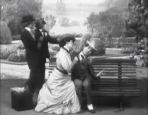 Les Résultats du féminisme (The Consequences of Feminism) (Dir. Alice Guy-Blaché, Fr, 1906) (Screening format – not known, 7 min) This silent comedy, directed by the visionary pioneer who helped create narrative cinema, shows a vision of a future of gender reversal in which men are the objects of sexual harassment and exploitation. Find out more at wikipedia.org Being screened as part of Woman of Wonders, an evening of short films and a panel discussion (including Silent London‘s Pam Hutchinson) to illustrate the power of women on screen. Castle Cinema, London E9 Link
Les Résultats du féminisme (The Consequences of Feminism) (Dir. Alice Guy-Blaché, Fr, 1906) (Screening format – not known, 7 min) This silent comedy, directed by the visionary pioneer who helped create narrative cinema, shows a vision of a future of gender reversal in which men are the objects of sexual harassment and exploitation. Find out more at wikipedia.org Being screened as part of Woman of Wonders, an evening of short films and a panel discussion (including Silent London‘s Pam Hutchinson) to illustrate the power of women on screen. Castle Cinema, London E9 Link
Brighton: Symphony Of A City (Dir. Lizzie Thynne, UK, 2015) + Le Voyage Dans la Lune (Trip to the Moon) (Dir. Georges Melies, Fr, 1902), (Screening format – not known, 48/13 mins). The daily activities and extraordinary events in the seaside town of Brighton are evocatively captured in modern silent Brighton: Symphony Of A City, wittily echoing the silent classic, Berlin Symphony of a City (1927). All-weather bathers plunge into winter seas at sunrise. Residents work, commute, flirt and play and do surprising things in their offices. Homelessness and gentrification collide; we glimpse forgotten attractions in  sparkling amateur movies from Screen Archive South East. ‘Father Neptune’ is dunked in a raucous ritual from 1951; 1930s marchers celebrate the anniversary of the Soviet Union and modern protestors commemorate Gaza. The elegant ferris wheel, a contemporary icon destined for destruction, marks the passage of time. The day culminates in night-time revelry, astounding puppetry and the winter solstice festival, ‘The Burning of the Clocks’. A kaleidoscopic view of this unique seaside town, which evokes the past in the present and the extraordinary in the everyday. Brighton Symphony of a City was a Brighton Festival Commission for its 50th anniversary in 2016 where it premiered with a live performance of the score by the Orchestra of Sound and Light. Find out more at
sparkling amateur movies from Screen Archive South East. ‘Father Neptune’ is dunked in a raucous ritual from 1951; 1930s marchers celebrate the anniversary of the Soviet Union and modern protestors commemorate Gaza. The elegant ferris wheel, a contemporary icon destined for destruction, marks the passage of time. The day culminates in night-time revelry, astounding puppetry and the winter solstice festival, ‘The Burning of the Clocks’. A kaleidoscopic view of this unique seaside town, which evokes the past in the present and the extraordinary in the everyday. Brighton Symphony of a City was a Brighton Festival Commission for its 50th anniversary in 2016 where it premiered with a live performance of the score by the Orchestra of Sound and Light. Find out more at  brightonsymphony.com. A Trip to the Moon is a 1902 French adventure film inspired by a wide range of sources, including the works of novelist Jules Verne The film
brightonsymphony.com. A Trip to the Moon is a 1902 French adventure film inspired by a wide range of sources, including the works of novelist Jules Verne The film  follows a group of astronomers who travel to the moon in a cannon-propelled capsule, explore its surface, escape from an underground city of lunar inhabitants and return to Earth. Filmed in the overtly theatrical style which marked out Méliès’ work, the film remains the best-known of the hundreds of films made by Méliès, and is widely regarded as the earliest example of the science fiction film genre and, more generally, as one of the most influential films in cinema history. Find out more at filmsite.org. Brighton: Symphony Of A City features a recorded score by composer Ed Hughes performed by the Orchestra of Sound and Light. Picture House, Greenwich Link
follows a group of astronomers who travel to the moon in a cannon-propelled capsule, explore its surface, escape from an underground city of lunar inhabitants and return to Earth. Filmed in the overtly theatrical style which marked out Méliès’ work, the film remains the best-known of the hundreds of films made by Méliès, and is widely regarded as the earliest example of the science fiction film genre and, more generally, as one of the most influential films in cinema history. Find out more at filmsite.org. Brighton: Symphony Of A City features a recorded score by composer Ed Hughes performed by the Orchestra of Sound and Light. Picture House, Greenwich Link
26 April
 Foolish Wives (Dir. Erich von Stroheim, US, 1922) (Screening format – not known, 117mins) In Stroheim’s 1922 film a con artist masquerades as Russian nobility and attempts to seduce the wife of an American diplomat. When released in 1922, the film was the most
Foolish Wives (Dir. Erich von Stroheim, US, 1922) (Screening format – not known, 117mins) In Stroheim’s 1922 film a con artist masquerades as Russian nobility and attempts to seduce the wife of an American diplomat. When released in 1922, the film was the most  expensive film made at that time, and billed by Universal Studios as the “first million-dollar movie” to come out of Hollywood. Originally, von Stroheim intended the film to run anywhere between 6 and 10 hours, and be shown over two
expensive film made at that time, and billed by Universal Studios as the “first million-dollar movie” to come out of Hollywood. Originally, von Stroheim intended the film to run anywhere between 6 and 10 hours, and be shown over two  evenings, but Universal executives opposed this idea. The studio bosses cut the film drastically before the release date. Find out more at sensesofcinema.com. With live musical accompaniment by John Sweeney. Austrian Cultural Forum, London SW7 Link
evenings, but Universal executives opposed this idea. The studio bosses cut the film drastically before the release date. Find out more at sensesofcinema.com. With live musical accompaniment by John Sweeney. Austrian Cultural Forum, London SW7 Link
26 – 28 April
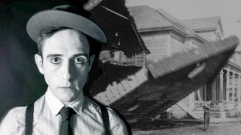 When You Fall Down Inspired by the career of Buster Keaton, James Dangerfield has created a musical that explores the silent star’s life and career. The show follows Keaton’s life from his first filmmaking experiences in 1917 to his signing on with MGM 11 years later. When You Fall Down previewed this year in London, and received its premiere at the 2017 International Buster Keaton Festival in Michigan, USA. Featuring original music and songs, join us for this show celebrating “The Great Stone Face” and the magic of movie-making. Tabard Theatre, Chiswick, London Link
When You Fall Down Inspired by the career of Buster Keaton, James Dangerfield has created a musical that explores the silent star’s life and career. The show follows Keaton’s life from his first filmmaking experiences in 1917 to his signing on with MGM 11 years later. When You Fall Down previewed this year in London, and received its premiere at the 2017 International Buster Keaton Festival in Michigan, USA. Featuring original music and songs, join us for this show celebrating “The Great Stone Face” and the magic of movie-making. Tabard Theatre, Chiswick, London Link
27 April
 London Symphony (Dir. Alex Barrett, UK, 2017) (Screening format – not known) London Symphony is a brand new silent film – a city symphony – which offers a poetic journey through London, a cosmopolitan city facing a challenge to its identity in the current political climate. It is an artistic portrait of the city as it stands today, and a celebration of its culture and diversity. Find out more at londonsymphfilm.com . With recorded James McWilliam soundtrack. The Brewhouse, Taunton, Somerset Link
London Symphony (Dir. Alex Barrett, UK, 2017) (Screening format – not known) London Symphony is a brand new silent film – a city symphony – which offers a poetic journey through London, a cosmopolitan city facing a challenge to its identity in the current political climate. It is an artistic portrait of the city as it stands today, and a celebration of its culture and diversity. Find out more at londonsymphfilm.com . With recorded James McWilliam soundtrack. The Brewhouse, Taunton, Somerset Link
28 April
 Laurel & Hardy Triple Bill Beginning with Flying Elephants’(Dir. Frank Butler, US, 1927) in which the boys are transplanted to pre-historic times and their bowler hats are substituted for Hollywood-issue caveman outfits. Next up is their final silent
Laurel & Hardy Triple Bill Beginning with Flying Elephants’(Dir. Frank Butler, US, 1927) in which the boys are transplanted to pre-historic times and their bowler hats are substituted for Hollywood-issue caveman outfits. Next up is their final silent  Unaccustomed as We Are (Dir. Lewis Foster, US, 1929, re-made as their first talkie) in which Ollie brings Stan home for dinner, much to the disgust of Mrs. Hardy who storms out leaving the coast clear for the pair to try their charms on beautiful neighbour Mrs. Kennedy (Thelma Todd). Finally, one of Laurel and Hardy’s best-loved shorts: Big Business (Dir.
Unaccustomed as We Are (Dir. Lewis Foster, US, 1929, re-made as their first talkie) in which Ollie brings Stan home for dinner, much to the disgust of Mrs. Hardy who storms out leaving the coast clear for the pair to try their charms on beautiful neighbour Mrs. Kennedy (Thelma Todd). Finally, one of Laurel and Hardy’s best-loved shorts: Big Business (Dir.  James Horne, US, 1928) which sees the duo gain-lessly occupied as door-to-door Christmas tree salesmen falling foul of short-tempered James Finlayson (Larbert-born local celebrity) with predictably but oh-so-satisfyingly destructive results. Presented as an encore screening from this year’s Hippodrome Silent Film Festival (HippFest). With live musical accompaniment by Jane Gardner (piano) and Hazel Morrison (percussion). Hippodrome Cinema, Bo’Ness, Scotland Link
James Horne, US, 1928) which sees the duo gain-lessly occupied as door-to-door Christmas tree salesmen falling foul of short-tempered James Finlayson (Larbert-born local celebrity) with predictably but oh-so-satisfyingly destructive results. Presented as an encore screening from this year’s Hippodrome Silent Film Festival (HippFest). With live musical accompaniment by Jane Gardner (piano) and Hazel Morrison (percussion). Hippodrome Cinema, Bo’Ness, Scotland Link
 Show People (Dir. King Vidor, US, 1928) (Screening format – not known, 79mins) This delightful King Vidor comedy features Marion Davies (also the film’s producer) as Peggy Pepper, an aspiring young actress fascinated by the allure of Hollywood. After meeting Billy Boone, the slapstick comedy actor
Show People (Dir. King Vidor, US, 1928) (Screening format – not known, 79mins) This delightful King Vidor comedy features Marion Davies (also the film’s producer) as Peggy Pepper, an aspiring young actress fascinated by the allure of Hollywood. After meeting Billy Boone, the slapstick comedy actor 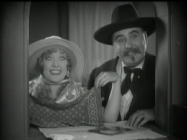 played by William Haines, Peggy begins her journey through the strange world of the dream factory. Davies is a knockout as the aspiring actress, but will her emerging ego destroy her career or will she realize who her real friends are? Look out for cameo appearances by Charlie Chaplin, Douglas Fairbanks, William S. Hart and King Vidor himself… as well as the real Marion Davies!! Find out more at moviessilently.com . With live organ accompaniment by Donald MacKenzie. St John’s Notting Hill, London Link
played by William Haines, Peggy begins her journey through the strange world of the dream factory. Davies is a knockout as the aspiring actress, but will her emerging ego destroy her career or will she realize who her real friends are? Look out for cameo appearances by Charlie Chaplin, Douglas Fairbanks, William S. Hart and King Vidor himself… as well as the real Marion Davies!! Find out more at moviessilently.com . With live organ accompaniment by Donald MacKenzie. St John’s Notting Hill, London Link
29 April
 Battleship Potemkin (Dir. Sergei Eisenstein, 1925) (Screening format – not known, 75mins) Considered one of the most important films in the history of silent pictures, as well as possibly Eisenstein’s greatest work, Battleship Potemkin brought Eisenstein’s theories of cinema art to the world in a powerful showcase; his emphasis on montage, his stress of intellectual contact, and his treatment of the mass instead of the individual as the protagonist. The film tells the story of the mutiny on the Russian ship Prince Potemkin during the 1905 uprising.Their mutiny was short-lived, however, as during their attempts to get the population of Odessa to join the uprising, soldiers arrived and laid waste to the insurgents. Battleship Potemkin is a work of extraordinary pictorial beauty and great elegance of form. It is symmetrically broken into five
Battleship Potemkin (Dir. Sergei Eisenstein, 1925) (Screening format – not known, 75mins) Considered one of the most important films in the history of silent pictures, as well as possibly Eisenstein’s greatest work, Battleship Potemkin brought Eisenstein’s theories of cinema art to the world in a powerful showcase; his emphasis on montage, his stress of intellectual contact, and his treatment of the mass instead of the individual as the protagonist. The film tells the story of the mutiny on the Russian ship Prince Potemkin during the 1905 uprising.Their mutiny was short-lived, however, as during their attempts to get the population of Odessa to join the uprising, soldiers arrived and laid waste to the insurgents. Battleship Potemkin is a work of extraordinary pictorial beauty and great elegance of form. It is symmetrically broken into five 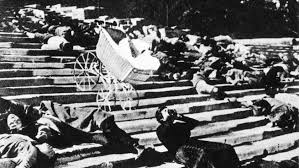 movements or acts. In the first of these, “Men and Maggots,” the flagrant mistreatment of the sailors at the hands of their officers is demonstrated, while the second, “Drama on the Quarterdeck,” presents the actual mutiny and the ship’s arrival in Odessa. “Appeal from the Dead” establishes the solidarity of the citizens of Odessa with the mutineers. It is the fourth sequence, “The Odessa Steps,” which depicts the massacre of the citizens, that thrust Eisenstein and his film into the historical eminence that both occupy today. It is unquestionably the most famous sequence of its kind in film history, and Eisenstein displays his legendary ability to convey large-scale action scenes. The shot of the baby carriage tumbling down the long staircase has been re-created in many films. The sequence’s power is such that the film’s conclusion, “Meeting the Squadron,” in which the Potemkin in a show of brotherhood is allowed to pass through the squadron unharmed, is anticlimactic. Find out more at classicartfilms.com. With live musical accompaniment by electro-improvisational group Grok. Genesis Cinema, London Link
movements or acts. In the first of these, “Men and Maggots,” the flagrant mistreatment of the sailors at the hands of their officers is demonstrated, while the second, “Drama on the Quarterdeck,” presents the actual mutiny and the ship’s arrival in Odessa. “Appeal from the Dead” establishes the solidarity of the citizens of Odessa with the mutineers. It is the fourth sequence, “The Odessa Steps,” which depicts the massacre of the citizens, that thrust Eisenstein and his film into the historical eminence that both occupy today. It is unquestionably the most famous sequence of its kind in film history, and Eisenstein displays his legendary ability to convey large-scale action scenes. The shot of the baby carriage tumbling down the long staircase has been re-created in many films. The sequence’s power is such that the film’s conclusion, “Meeting the Squadron,” in which the Potemkin in a show of brotherhood is allowed to pass through the squadron unharmed, is anticlimactic. Find out more at classicartfilms.com. With live musical accompaniment by electro-improvisational group Grok. Genesis Cinema, London Link
